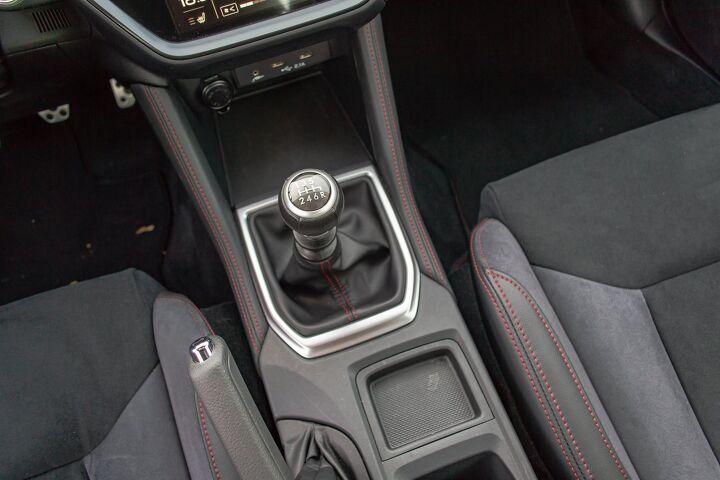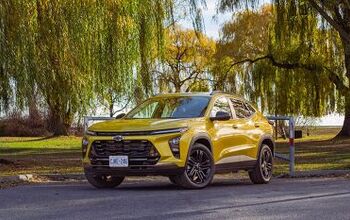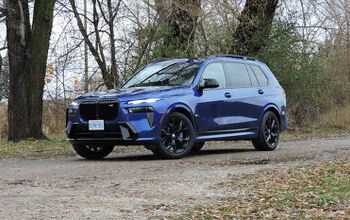Subaru WRX Manual Vs Automatic Comparison


After the looks, the most controversial part of the 2022 Subaru WRX reveal was its automatic transmission.
It’s not that a self-shifting WRX didn’t already exist: the last-generation model had a CVT, too. But for this one, Subaru wants to put space between its iconic sport compact and the image of a droning econo ‘box. So say goodbye to see-vee-tee, hello ess-pea-tea, or Subaru Performance Transmission. It’s quicker now, and more involving, at least according to Subaru.
Get a Quote on a New 2022 Subaru WRXWe couldn’t resist the opportunity to put that to the test. In our latest inter-brand comparison, managing editor Mike Schlee and I spent a week with both versions of the WRX to see just how well the new SPT lives up to its name. Not only that, does the six-speed keep the WRX magic alive? It’s time to find out.
Style

We first saw this latest WRX a solid year ago. In general shape, it’s evolutionary, a slightly blobby sedan with a low nose and a high, pinched tail. It’s the details that seem to rankle a lot of folks. Yep, we’re talking about the cladding. I’m not too bothered by it; after all, hasn’t the WRX survived on a reputation of all-surfaces supremacy? Nonetheless, we can’t deny the dark gray car hides the cladding better. Subaru says it’s there for aerodynamic purposes, but that could still be true in body color. The hope was that the STI might do just that, but the STI is dead for this generation.
In a world of raucous Elantras and 300-horsepower Corollas, the WRX almost seems like the restrained option these days. It keeps the iconic hood scoop, sure, but pick one of the more subdued shades and it almost blends in. There’s a definite family resemblance to the BRZ in those angular taillights, though just like the last-gen’s units, they still make the tail look narrow. There’s some cool fractal surfacing inside the red elements, a welcome detail from traditionally conservative Subaru.
SEE ALSO: Honda Civic Si vs Volkswagen Golf GTI vs Hyundai Elantra N: Sport Compact Shootout
Cabin Space

No longer is the WRX interior a penalty box of Kinder Surprise levels of quality. The latest model meshes the familiar layout fans will know with a few choice touches from big brother Legacy. It’s not going to win any style awards against the Civic or Elantra, but the WRX is an easy car to get in and get familiar with. The contrast stitching in these two testers—the Limited trim in the US, or Sport-Tech in Canada—adds a touch of class, tracing the dashboard, seats, and steering wheel. A flat-bottom steering wheel seems too fad-ish for a Subaru, but it’s a good size with the right thickness. Subaru has mercifully kept piano black trim to a minimum here, only surrounding the SPT’s center console. There’s none in the manual.
The seats nail the balance between everyday comfort and weekend drive support, featuring enough hip- and shoulder bolstering without feeling constrictive. The Ultrasuede is soft and breathable, too. Seat heating is included in both rows, and it’s some of the most effective warming we’ve experienced.

For better or worse, there’s something very normal compact sedan about sitting in the back of the WRX. Other than the occasional parp-parp from the exhaust, this is a perfectly acceptable space to shuttle folks around in. There’s good legroom; not class-leading, but not far off, either. Headroom is a little tight, both in sheer numbers (36.7 inches / 932 millimeters) and in feel, with the bump from the moonroof right in view.
Powertrain, Driving Feel, and Fuel Economy

No matter which transmission WRX buyers opt for, they’ll find the same engine under that hood scoop. It’s the larger 2.4-liter Boxer-four from the Ascent, with horsepower up slightly to 271, and torque unchanged from before at 258 pound-feet. The extra low-down torque makes the WRX an easier car to live with in stop-and-go traffic, especially in the manual. Initial responses are a little tardy compared to the effervescent Elantra N or Golf GTI, but from 2,000 rpm the Subaru has a strong surge that suggests Subaru might even be underrating it by a few ponies.
Those other cars might be sharper, but the WRX’s strength lies in its sheer chuckability. “One of the easiest cars to just get in and drive fast,” notes Schlee, adding that a drive can “approach many of its limits on the street while grinning the entire time.” He nails it: there’s a comfortable, familiar limberness to the WRX’s input points that make it instantly trustworthy. The lack of myriad drive modes is a bonus, too. Other cars might bite if you push past their limits before they’re good and ready; the WRX just asks for more.

When you’re not wringing its neck, the WRX is now a much more pleasant everyday companion, too. The improved chassis achieves that win-win goal of better handling and a more forgiving ride.
So what separates the two transmissions? The SPT model gets Subaru’s Variable Torque Distribution, which provides a very slight rear bias in the AWD system, instead of the 50/50 split in the manual model. It can run up to that same split if the conditions call for it, too. On a track that sort of difference might be noticeable, but on the road it sure isn’t.
The ol’ reliable six-speed is, in the words of Schlee, “still a rough, unrefined transmission.” It does its job, but it’s not a shifter we’d wax lyrical about. That said, it’s dummy-easy to operate, and almost impossible to miss a gear. It spreads an additional level of fun onto an already grin-inducing ride. By comparison, the SPT is sure quick. Subaru has programmed in distinct “shift points,” and while it never fully disengages drive, the rubberband feeling is a split second. Responses from the wheel-mounted paddle shifters are pretty good, too. Want even more aggressive action? The SI Drive selector is right there.

We’d be lying if we said it was as fun or as involving as the manual, though. Left to its own devices, the WRX SPT ends up feeling like a louder, grippier Legacy. For some that will be enough, as even just the availability of a two-pedal WRX opens it up to more folks. But the WRX thrives when it’s involving the driver, and no matter how refined a continuously variable transmission becomes, it can never accomplish that as well as a manual. Even a DCT offers more drama.
Perhaps most surprising, the SPT is also thirstier. Neither of us drove with particularly light feet during the week, but the manual averaged 21 mpg (11.2 L/100 km), while the SPT could only hit 19 mpg (12.3 L/100 km).
Cargo Space

There might be different transmissions up front, but there’s no telling these two WRXs apart out back. The trunk is the same 12.5 cubic feet (354 liters) for both, with the same awkwardly tapering aperture. A 60/40-folding rear bench makes it possible to load larger items in.
SEE ALSO: Hyundai Elantra N vs Hyundai Kona N: Hot or HotterSafety

Subaru’s EyeSight driver assist suite is only compatible with its two-pedal models, so it’s here that the SPT gains an advantage. Yes, both cars get a battery of airbags, automatic collision notification, and LATCH setups for kids, but the manual misses out on most driver assists beyond high beam assist, blind spot assist and rear cross-traffic alert. The auto, meanwhile, features adaptive cruise control, automated emergency braking, lane-keep assist, and lane departure alert.
Equipped with the SPT, the WRX earns the Insurance Institute for Highway Safety (IIHS) Top Safety Pick+ rating.
Subaru WRX Manual vs Automatic: Tech and Features

Both testers eschew the odd dual-7.0-inch screen setup of the base car for Subaru’s familiar 11.6-inch, portrait-style infotainment screen. It’s a fine setup—not pretty, but more than capable of getting the job done. Subaru is one of the few automakers yet to dabble with wireless phone mirroring, but the advantage there is foolproof Apple CarPlay and Android Auto actuation. Besides, there’s no wireless charger, anyway. Every WRX beyond the base model has USB ports in the back row, too.

A lower center console in the manual-equipped car robs rear-seat passengers of a tiny storage cubby, but beyond that and the afore-mentioned EyeSight, these two are pretty much identical. There’s even heated rear seats now, and the driver benefits from a 10-way power-adjustable seat. Dual-zone climate control is also standard on all models except the base WRX.
Subaru WRX Manual vs Automatic: Pricing

A bone-stock WRX now cracks the $30,000 barrier, ringing in at $30,600 ($32,720 CAD) including destination. That’ll net buyers a six-speed model; the SPT is an $1,850 up-charge in the US, and it’s not even available on the base in Canada. Sure, you’ll be making some creature comfort concessions, but that’s a lot of performance for not a lot of cash.
From there, buyers have the choice of the $33,100 Premium ($37,220 CAD Sport in Canada), or these Limited (Sport-Tech) examples. The latter adds the larger infotainment system with navigation, Harman Kardon sound system, adaptive headlights, and other goodies. As equipped, the manual car is $37,490 ($41,020 CAD), while the SPT rings in at $39,740 ($43,620 CAD). Curiously, the SPT becomes $200 more expensive each trim up in the US; it’s a flat $2,600 CAD north of the border.
In America, there’s also the fancy WRX GT ($43,390). This one drops in electronic dampers, Recaro seats, and selectable drive modes—and is SPT-only.
SEE ALSO: Subaru WRX STI is Dead (For Now)Subaru WRX Manual vs Subaru WRX Automatic: Verdict

Calling the 2022 Subaru WRX SPT the best-performing CVT out there feels like a backhanded compliment. It was a low bar, after all.
The good news is that the advancements Subaru has wrought on the 2022 model are available for both transmissions. The new WRX handles better, both when you’re giving it hell on a backroad, or simply crawling through morning traffic. The SPT opens up that scruff-of-the-neck experience to more people, and for that, we’re happy it exists, even if it feels more sanitized than even a modern DCT.
Still, a row-your-own setup is more in tune with the WRX’s simple-pleasures vibe. For the full WRX experience, we’d still recommend the six-speed manual.
Become an AutoGuide insider. Get the latest from the automotive world first by subscribing to our newsletter here.

Kyle began his automotive obsession before he even started school, courtesy of a remote control Porsche and various LEGO sets. He later studied advertising and graphic design at Humber College, which led him to writing about cars (both real and digital). He is now a proud member of the Automobile Journalists Association of Canada (AJAC), where he was the Journalist of the Year runner-up for 2021.
More by Kyle Patrick































Comments
Join the conversation
good
Could have taken the comparison practically